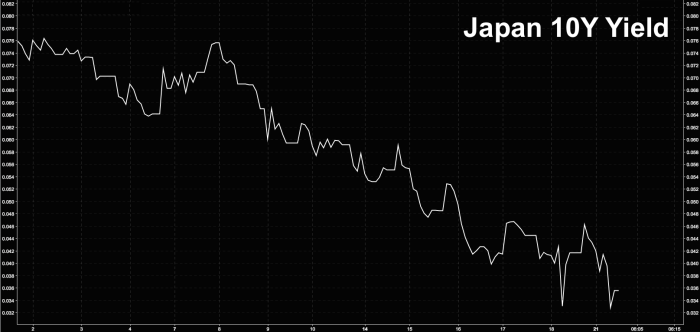Right, so last week, the BoJ cut purchases of 5-to-10 year JGBs by JPY30 billion to JPY440 billion at its regular operations on Wednesday.
Obviously, they’re trying to squeeze these little nods at tapering in whenever circumstances permit so they can to give themselves some room in the event they need to mash on the accelerator even harder in the future (although the pedal is already to the metal).
Really, it kind of seems like they may be targeting 10Y yields between 0.05% and 0.10% as opposed to 0% to 0.10% which makes you wonder what they might do now that the chart looks like this:

Â
Well anyway, the market didn’t react much when the 440 billion number mentioned above crossed the tape. Nomura had this explanation:
Lack of market reaction is due to lack of momentum for yields to rise given low volatility in Japan and the U.S. Also due to lack of sellers as the 10-year zone is favored by investors seeking to park money compared to the BOJ’s reserve that carries a 0.1% charge.
We offered a simpler narrative:
barely any reaction to BoJ reducing 5-10Y purchases.
why? because the damn market doesn’t work anymore.
— Walter White (@heisenbergrpt) August 16, 2017
In light of that, consider the following brief bit of color out this morning from Bloomberg’s Masaki Kondo:
Japan’s government bond market feels like it’s on life support, with the rolling 10-month average for JGB trading volume sliding to a fresh all-time low in July, according to new data from the Japan Securities Dealers Association. This shrinking investor activity in bonds is a result of the central bank’s quantitative easing program and the thinness of the market means a sharp drop in prices has the potential to accelerate more quickly. Encouraged by low volatility, a lack of inflation and a backstop by the BOJ, investors have been taking on more duration risk, so if there is an unexpected major reversal, it could be very rapid and very painful.

